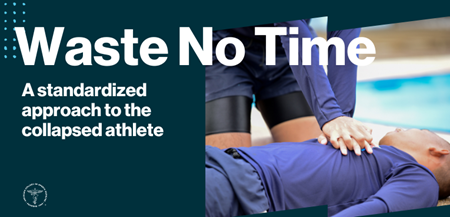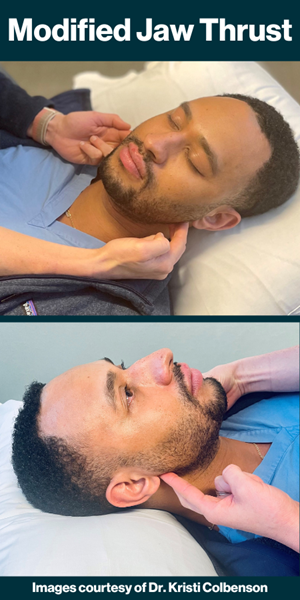Kristi Colbenson, M.D. and Neha Raukar, M.D., M.S. |
Jan.
5, 2023
 As emergency medicine and sports medicine physicians, we have advocated for all sideline providers to not just be basic life support (BLS) certified but consistently prepare themselves mentally to manage the complex and emotionally charged scene of the collapsed athlete. All sports medicine providers and sideline personnel should reflect on the event that unfolded on Jan. 2 during Monday Night Football and recognize it is not a matter of if, but when. When you find yourself in that moment, your actions need to be reflexive and efficient, and your mindset needs to be algorithmic. Every second matters to optimize not just the athlete’s survival but also their neurologic outcome. Here, we present three critical steps to standardize the care of the collapsed athlete.
As emergency medicine and sports medicine physicians, we have advocated for all sideline providers to not just be basic life support (BLS) certified but consistently prepare themselves mentally to manage the complex and emotionally charged scene of the collapsed athlete. All sports medicine providers and sideline personnel should reflect on the event that unfolded on Jan. 2 during Monday Night Football and recognize it is not a matter of if, but when. When you find yourself in that moment, your actions need to be reflexive and efficient, and your mindset needs to be algorithmic. Every second matters to optimize not just the athlete’s survival but also their neurologic outcome. Here, we present three critical steps to standardize the care of the collapsed athlete.
A-C … AED
A: Airway — Modified Jaw Thrust
The first step is action, and while this may in concept seem easy, it is hardest part of the algorithm. Athletes in cardiovascular collapse may exhibit myoclonic jerking or agonal respirations, which can be confused with purposeful movement and can lead to delays in intervention.

Overcoming the mental hurdle to proceed to CPR is difficult. The first step in recognition should be an objective, efficient maneuver to identify the athlete’s consciousness: the modified jaw thrust. This maneuver is done by placing two fingers just superior to the angle of the mandible and just inferior to the tragus of the ear. You then displace the mandible anteriorly.
This is a powerful maneuver that serves two purposes: First, it is a means of allowing passive ventilation by removing obstructed oropharyngeal tissue when an athlete is unconscious. Second, and most importantly, it is a significant pain generator. If the athlete does not grimace, take a breath or respond purposefully to this intervention, you need to immediately get yourself and your team on the same mental model that this is a critical situation.
It is easy to become distracted and not take the right steps in cardiovascular collapse, but if everyone on the resuscitation team agrees that the modified jaw thrust is not intact, then you commit to progressing to the next step of the algorithm.
C: Carotid Pulse and Continual Compressions
The next step is to immediately drop your hands from the angle of the mandible just inferiorly and anterior to the sternocleidomastoid muscle to feel for the carotid pulse. The carotid pulse is the last pulse to be lost, so it should be the only pulse we use precious time in order to palpate. It can be difficult to determine if it is present or absent in cardiovascular collapse, so don’t spend more than five seconds searching for it.
If the modified jaw thrust is abnormal and you can’t feel a pulse, the next step is to start compressions. Good-quality compression entails a rate of at least 100 beats per minute and should compress the chest two-and-a-half inches at the mid-sternal location. During the first few minutes of cardiac collapse in athletes, your goal is to perfuse the myocardium and the brain as efficiently as possible, and that is done through minimizing disruptions in compression. Sudden collapse in an athlete deviates from standard BLS in that the primary etiology in a young, healthy athlete is most likely a non-perfusing cardiac arrhythmia, and emphasis should be placed on re-establishing perfusion; therefore, rescue breaths can be delayed until after the first shock with an AED. In fact, with a persistent modified jaw thrust maneuver, athletes can go minutes in apnea before they become hypoxic. Perform compression-only CPR until the AED arrives.
AED
The underlying cause of sudden cardiac collapse in athletes is complex, but during a resuscitation, the specific cause does not matter: Sudden cardiac collapse on the sideline results from a non-perfusing rhythm, either pulseless ventricular tachycardia or ventricular fibrillation. Therefore, the role of the sideline provider is to rapidly get the AED on the athlete so they can be cardioverted back to a perfusing rhythm. In the first few moments of a resuscitation, it is that simple. Every minute that defibrillation is delayed, the chance of survival decreases by 10%. AEDs must be on the field, and every sideline provider must be efficient in equipment removal and AED placement.
We emphasize that the constant cognitive practice of the A-C … AED algorithm is imperative so that when you find yourself in that critical moment, there is no delay and no distraction but instead confident commitment to:
A: Airway — Modified jaw thrust (Call for an ambulance and the AED.)
C: Carotid pulse and compression-only CPR
AED: Get a perfusing rhythm back.
Kristina "Kristi" Colbenson, M.D., is an assistant professor of emergency medicine and sports medicine at the Mayo Clinic in Rochester, Minnesota. She is also an associate program director for the Emergency Medicine program. Dr. Colbenson has served as a team physician for numerous high school, collegiate and semiprofessional teams, including USA Nordic.
Neha Raukar, M.D., M.S., is a practicing physician in both sports medicine and emergency medicine, and is active in education, clinical medicine, legislation and research. Her sideline experience spans the breadth from high school, collegiate and Olympic athletes. An associate professor at the Mayo Clinic, her research interests include injuries and life-threatening diseases in athletes, including head injury, heat illness and sudden cardiac death.
References
Fowler R, Chang MP, Idris AH. Evolution and revolution in cardiopulmonary resuscitation. Curr Opin Crit Care. 2017;23(3):183-7.
Harmon KG. Incidence and causes of sudden cardiac death in athletes. Clin Sports Med. 2022;41(3):369-88.
Harmon KG et al. Pathogeneses of sudden cardiac death in national collegiate athletic association athletes. Circ Arrhythm Electrophysiol. 2014 Apr;7(2):198-204.
Marx JM, Hockberger R, Walls R. Rosen’s Emergency Medicine: Concepts and Clinical Practice. 5th ed. St. Louis (MO): Mosby; 2002. Chapter 5.
Peterson DF et al. Aetiology and incidence of sudden cardiac arrest and death in young competitive athletes in the USA: a 4-year prospective study. Br J Sports Med. 2021 Nov;55(21):1196-1203.
Rank W. AHA update: BLS, ACLS, and PALS. Nursing. 2021;51(6):22-7.
Sweeting J, Semsarian C. Sudden cardiac death in athletes: still much to learn. Cardiol Clin. 2016;34(4):531-541. doi: 10.1016/j.ccl.2016.06.003. Epub 2016 Aug 28. PMID: 27692222.